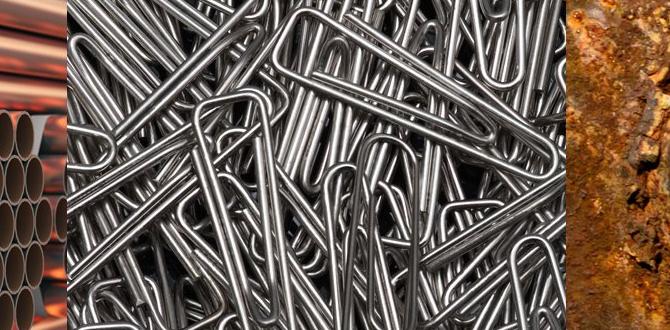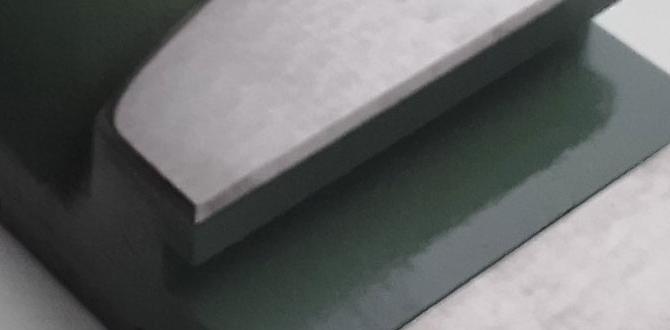Quick Summary:
For achieving smooth, high-quality finishes on mild steel with a ball nose end mill, applying a TiAlN coating is a proven method. This coating enhances durability, heat resistance, and chip evacuation, leading to cleaner cuts and extended tool life, even at lower speeds suitable for beginners.
Tialn Ball Nose End Mill: Your Key to Superior Mild Steel Finishing
Hey there, fellow makers! Daniel Bates here from Lathe Hub. Are you wrestling with those fuzzy edges and uneven surfaces when finishing mild steel? It’s a common headache, especially when you’re just starting out. You’ve got your workpiece clamped, your machine humming, but the final cut just isn’t living up to your vision. Don’t worry, it’s a hurdle many of us have faced. Today, we’re diving into a fantastic solution that will make those finishing passes a dream: the TiAlN coated ball nose end mill. We’ll walk through exactly why this tool is a game-changer for mild steel and how you can use it to achieve that professional, glass-smooth finish you’re after. Let’s get those parts looking exactly how you want them!
What is a Ball Nose End Mill?
Before we get to the special coating, let’s quickly chat about the tool itself. A ball nose end mill is a type of cutting tool used in milling machines. Unlike flat-bottomed end mills, its tip is perfectly rounded, like the end of a ball. This unique shape is incredibly versatile, making it ideal for creating curved surfaces, fillets, and, crucially for us, achieving excellent surface finishes.
Think of it like this: a flat end mill is great for making square pockets, but a ball nose end mill can smoothly carve out complex shapes and contours. This rounded tip means it can engage with the material at various angles, reducing chipping and providing a more consistent cut, especially as you move across a surface.
Why is Finishing Mild Steel Tricky?
Mild steel, while a fantastic and versatile material for many projects, can be a bit unforgiving during finishing. It’s prone to work hardening, meaning the surface can become tougher as you machine it, leading to tool chatter and rough finishes. It also tends to form long, stringy chips that can weld themselves to the cutting edge of your tool. This welding, known as built-up edge (BUE), degrades the tool’s performance and leaves a poor surface finish on your workpiece.
These issues can be frustrating for beginners because they often require fine-tuning your cutting parameters (speed, feed, depth of cut) and can even necessitate specific tool geometries. Without the right approach, you might find yourself going over the same area multiple times, only to get a less-than-perfect result. This is where the right tool, like our TiAlN coated ball nose end mill, makes all the difference.
Introducing the TiAlN Coating: Your Secret Weapon
So, what makes a TiAlN coated ball nose end mill so special for mild steel finishing? TiAlN stands for Titanium Aluminum Nitride. It’s a thin, extremely hard coating applied to the surface of the end mill. This coating isn’t just for show; it brings some serious benefits to your machining:
- Increased Hardness: TiAlN is incredibly hard, significantly harder than the tool steel itself. This helps the cutting edge resist wear and abrasion, meaning it stays sharp for longer.
- High-Temperature Resistance: Machining generates heat. TiAlN forms a protective oxide layer at high temperatures. This layer acts as a barrier, preventing the heat from transferring directly to the tool’s cutting edge, which reduces the chances of the tool softening or degrading.
- Reduced Friction: The smooth, slick surface of the TiAlN coating reduces friction between the tool and the workpiece. This means less heat build-up and less chance of chips welding to the tool.
- Improved Chip Evacuation: With less friction and a smoother surface, chips tend to flow off the tool more cleanly, reducing the risk of re-cutting chips and damaging the surface finish.
For mild steel, this coating is particularly beneficial because it combats the tendency for stringy chip formation and built-up edge. The TiAlN coating maintains a sharper edge and reduces the heat that encourages those nasty chips to stick. This allows for a cleaner cut and a much smoother surface finish.
Why TiAlN for Finishing?
When we talk about finishing, we’re aiming for the best possible surface quality. This means a smooth, almost mirrored surface with minimal tool marks. The TiAlN coating excels here for a few key reasons related to finishing mild steel:
- Consistent Cut: The coating’s hardness and heat resistance allow the tool to maintain its sharp edge throughout the finishing pass. A sharp edge is critical for a clean cut and avoiding the tearing that leads to a rough surface.
- Reduced Built-Up Edge (BUE): As mentioned, mild steel can create BUE. TiAlN’s slick surface helps prevent this, ensuring the tool cuts cleanly rather than dragging material.
- Better Heat Management: Even at finishing speeds, some heat is generated. TiAlN’s thermal barrier properties keep the cutting edge cooler, which is vital for maintaining its geometry and thus the surface finish.
- Smoother Chip Flow: The refined chip flow prevents chips from interfering with the cutting process, which can cause scratches or poor surface quality.
In essence, the TiAlN coating transforms a good ball nose end mill into a superior one for achieving those critical fine details and smooth transitions on mild steel.
Choosing the Right TiAlN Ball Nose End Mill
Not all TiAlN coated ball nose end mills are created equal. For beginners working with mild steel, let’s focus on a few key specifications that will make your life easier and your results better.
Material and Coating Type
For mild steel finishing, a Carbide end mill is generally preferred over High-Speed Steel (HSS). Carbide offers better rigidity and can handle higher cutting speeds (though we’ll be mindful of that for finishing) and temperatures. The TiAlN coating is a great choice, offering excellent performance on steels. You might also see other coatings like TiCN or AlTiN, but TiAlN is a reliable all-rounder for this application.
It’s worth noting that many TiAlN coatings are applied with a specific thickness and structure optimized for certain materials. For finishing mild steel, a high-quality, well-applied TiAlN coating is more important than a complex multi-layer coating.
Number of Flutes
End mills come with different numbers of cutting edges, called flutes. For finishing, especially in materials like mild steel that can produce long chips, fewer flutes are often better. Why?
- 2 Flutes: These are excellent for finishing and general-purpose work in softer metals like aluminum and mild steel. They provide ample space for chips to exit the cutting zone, reducing the risk of chip recutting and ensuring a cleaner finish. For mild steel, 2 flutes are a very safe and effective choice for finishing.
- 4 Flutes: While great for heavy material removal and harder steels, 4-flute end mills have less chip clearance. For finishing mild steel, they can sometimes lead to chip packing and a less-than-ideal surface finish if not managed carefully with appropriate speeds and feeds.
Recommendation for Beginners: Start with a 2-flute TiAlN coated ball nose end mill. This combination offers the best balance of chip evacuation and cutting performance for smooth finishing on mild steel.
Helix Angle
The helix angle refers to the “twist” of the flutes. Common angles are 30 degrees, 45 degrees, and 35 degrees (often called “standard”). For finishing operations, especially on softer materials like mild steel, a standard helix angle (often around 30-35 degrees) is typically sufficient. A higher helix angle (like 45 degrees) can offer a smoother cut but might be less rigid. For most beginner finishing tasks on mild steel, a standard helix angle on your TiAlN ball nose end mill will work perfectly.
Diameter and Radius
The diameter of the end mill will depend on the features you need to create. Ball nose end mills are available in a wide range of diameters. The radius of the ball is half the diameter. For general-purpose finishing and creating smooth contours, you’ll likely use a diameter that suits the scale of your project. Common sizes like 1/4 inch (6mm) or 1/2 inch (12mm) are great starting points.
The radius of the ball end determines the sharpness of the internal corners it can achieve. A full radius (e.g., a 1/2 inch diameter tool has a 1/4 inch radius) is perfect for smooth, sweeping curves.
Setting Up for Success: Speeds, Feeds, and Passes
This is where the magic happens! Getting the right settings is crucial for maximizing the benefits of your TiAlN coated ball nose end mill on mild steel. Remember, we are focusing on finishing, so we’re aiming for quality over speed.
Disclaimer: These are starting points. Always listen to your machine and your tool. If you hear chatter, see excessive vibration, or notice poor chip formation, adjust your settings accordingly. Machining is a tactile experience!
Cutting Speeds (Spindle RPM)
For mild steel with a carbide tool, a general starting point for surface speed (SFM or SMM) is around 200-400 SFM (60-120 SMM). However, for finishing with a ball nose end mill, especially a coated one, you often want to run a bit slower to ensure that smooth surface and allow the coating to work its magic without overheating.
A good starting point for RPMs on a TiAlN coated carbide ball nose end mill in mild steel for finishing would be:
- Diameter 1/4″ (6mm): 1500 – 2500 RPM
- Diameter 1/2″ (12mm): 1000 – 2000 RPM
These are conservative speeds. You can often push them higher once you gain confidence and observe the chip formation. The key is a consistent, relatively fine chip.
Feed Rates (IPM or MMPM)
Feed rate is how fast the tool moves through the material. For finishing, you want a feed rate that allows the cutting edge to shave off a fine layer of material. Too fast, and you risk chatter; too slow, and you might rub the tool, generating excess heat.
A common guideline for finishing is to aim for a chip load (the thickness of the chip each flute cuts) of around 0.001″ to 0.003″ per tooth (0.025mm to 0.075mm). For finishing, we lean towards the lower end.
Here are some starting feed rates:
- Diameter 1/4″ (6mm), 2 Flutes: 10 – 20 IPM (250 – 500 MMPM)
- Diameter 1/2″ (12mm), 2 Flutes: 15 – 30 IPM (380 – 760 MMPM)
Again, these are starting points. Listen to the cut! A smooth, consistent sound is what you’re listening for.
Depth of Cut (DOC) – For Finishing
When finishing, the depth of cut should be very light. We are essentially trying to achieve that final, perfect surface, not remove significant material. A typical finishing DOC with a ball nose end mill on mild steel might be:
- Radial Depth of Cut (Stepover): 20% – 50% of the tool diameter is common for contouring or rastering. For ultimate smoothness, you might go even lower (10-20%). This refers to how much the tool moves sideways between passes.
- Axial Depth of Cut: For pure surface finishing where the tool is grazing the surface, this can be as little as 0.010″ to 0.030″ (0.25mm to 0.75mm). If you are using the ball nose to create a fillet or a rounded edge, you might take a slightly deeper axial cut, but always keep it light for finishing.
Crucial for Ball Nose: When using a ball nose end mill for surface finishing, ensure that your toolpath is programmed to engage the ball radius correctly. Many CAM software packages have specific “ball end finishing” routines that do this automatically, ensuring you’re using the best part of the tool for a uniform finish.
Coolant and Lubrication
While TiAlN offers excellent dry machining capabilities by resisting heat, using a coolant or lubricant can still enhance performance and surface finish, especially for longer runs or when pushing the tool a bit harder. For mild steel, flood coolant is ideal if your machine is equipped with it.
If flood coolant isn’t an option, consider:
- Mist Coolant: A fine mist of coolant directed at the cutting zone provides lubrication and cooling without flooding the machine.
- Cutting Fluid/Paste: For smaller machines or manual setups, a dab of cutting paste or fluid on the tool or workpiece can significantly help. This is especially useful for preventing galling (a form of BUE) on mild steel.
A good quality synthetic cutting fluid designed for ferrous metals is a great choice. It helps with chip evacuation, cools the cutting edge, and reduces friction, all contributing to a better finish and longer tool life.
Step-by-Step Finishing Process with Your TiAlN Ball Nose End Mill
Let’s walk through the process of using your TiAlN coated ball nose end mill for that perfect final touch on mild steel.
Step 1: Prepare Your Workpiece and Machine
- Ensure your mild steel workpiece is securely clamped. Double-check that there’s no movement or vibration.
- Clean your machine’s spindle and tool holder. Ensure the tool holder is clean and free of debris.
- Set up your work offsets correctly. Accuracy here is vital for a good finish.
Step 2: Load the Tool
- Insert your TiAlN coated ball nose end mill into a clean and appropriate tool holder (e.g., an ER collet chuck).
- Ensure the tool is seated correctly and tightened securely.
- If using a tool length setter, measure the tool length accurately for your CNC program.
Step 3: Program Your Toolpath (or Set Up Manually)
- For CNC: Program your finishing toolpath. Use a “contour” or “surface finish” strategy. Set your RPM, feed rates, axial depth of cut, and radial stepover according to the guidelines above. Ensure your CAM software is set to use the ball nose radius correctly across the surface. Many programs use a raster path (back and forth) or a contour-parallel path.
- For Manual Machining (Manual Mill): If you’re doing this manually, set your spindle speed (RPM) and carefully control your feed using the machine’s handwheels. You’ll likely be using a sweeping motion or a very controlled back-and-forth movement. This requires practice and a very light touch for finishing.
Step 4: Apply Coolant/Lubrication
- Turn on your coolant system (flood or mist) or apply your cutting fluid/paste to the cutting zone.
- Ensure coolant is directed at the point where the tool meets the material.
Step 5: Execute the Finishing Pass
- Start the spindle.
- Initiate the feed.
- Listen! Pay attention to the sound of the cut. It should be a consistent, light “shaving” sound. Any chattering, grinding, or high-pitched squealing indicates an issue with your speeds, feeds, depth of cut, or workpiece rigidity.
- Watch the chip formation. You want to see small, relatively clean chips exiting the flutes, not long, stringy ones or dust. The TiAlN coating usually promotes this.
- Monitor the surface finish as the tool moves. It should progress from rough to smooth.
Step 6: Inspect and Adjust
- Once the finishing pass is complete, stop the spindle and carefully inspect the surface finish.
- Are there tool marks? Is it smooth and consistent?
- If everything looks good, congratulations! You’ve achieved a great finish.
- If not, review your settings. Was the feed rate too high? Was the depth of cut too deep? Was there vibration? Make small adjustments and try again on a test piece or a less critical area.
A really useful resource for understanding material properties and machining parameters is the National Institute of Standards and Technology (NIST) Manufacturing Division. They provide valuable data on materials and processes that can help inform your approach.








